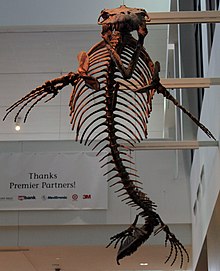| Mosasaurines Temporal range: Late Cretaceous,
| |
|---|---|

| |
| Mounted skeleton of Mosasaurus conodon, Minnesota Science Museum | |
| Scientific classification | |
| Domain: | Eukaryota |
| Kingdom: | Animalia |
| Phylum: | Chordata |
| Class: | Reptilia |
| Order: | Squamata |
| Clade: | †Mosasauria |
| Family: | †Mosasauridae |
| Subfamily: | †Mosasaurinae Gervais, 1853 |
| Type species | |
| †Mosasaurus hoffmannii Mantell, 1829
| |
| Genera | |
The Mosasaurinae are a subfamily of mosasaurs, a diverse group of Late Cretaceous marine squamates. Members of the subfamily are informally and collectively known as "mosasaurines" and their fossils have been recovered from every continent except for South America.[4]
The lineage first appears in the Turonian and thrived until the K-Pg mass extinction at the end of the Maastrichtian. They ranged in size from some of the smallest known mosasaurs (Carinodens, 3–3.5 meters), to medium-sized taxa (Clidastes, 6+ meters), to the largest of the mosasaurs (Mosasaurus hoffmannii) potentially reaching about 13 m in length. Many genera of mosasaurines were either piscivorous or generalists, preying on fish and other marine reptiles, but one lineage, the Globidensini, evolved specialized crushing teeth, adapting to a diet of ammonites and/or marine turtles.
Though represented by relatively small forms throughout the Turonian and Santonian, such as Clidastes, the lineage diversified during the Campanian and had by the Maastrichtian grown into the most diverse and species-rich mosasaur subfamily.[5]
The etymology of the group derives from the genus Mosasaurus (Latin Mosa = "Meuse river" + Greek sauros = "lizard").
- ^ DeBraga, Michael; Carroll, Robert L. (1993), Hecht, Max K.; MacIntyre, Ross J.; Clegg, Michael T. (eds.), "The Origin of Mosasaurs as a Model of Macroevolutionary Patterns and Processes", Evolutionary Biology, Boston, MA: Springer US, pp. 245–322, doi:10.1007/978-1-4615-2878-4_7, ISBN 978-1-4615-2878-4, retrieved 2022-07-13
- ^ Konishi, Takuya; Ohara, Masaaki; Misaki, Akihiro; Matsuoka, Hiroshige; Street, Hallie P.; Caldwell, Michael W. (2023). "A new derived mosasaurine (Squamata: Mosasaurinae) from south-western Japan reveals unexpected postcranial diversity among hydropedal mosasaurs". Journal of Systematic Palaeontology. 21 (1). doi:10.1080/14772019.2023.2277921. ISSN 1477-2019.
- ^ Kaddumi, Hani F. (2009). "A new durophagous mosasaur (Squamata: Mosasauridae) from the Maastrichtian Muwaqqar Chalk Marl Formation of the Harrana Fauna". Fossils of the Harrana Fauna and the Adjacent Areas. Amman: Eternal River Museum of Natural History. pp. 36–48. OCLC 709582892.
- ^ "Fossilworks: Mosasaurinae". fossilworks.org. Retrieved 17 December 2021.
- ^ Polcyn, Michael J.; Jacobs, Louis L.; Araújo, Ricardo; Schulp, Anne S.; Mateus, Octávio (2014-04-15). "Physical drivers of mosasaur evolution". Palaeogeography, Palaeoclimatology, Palaeoecology. Physical drivers in the evolution of marine tetrapods. 400: 17–27. doi:10.1016/j.palaeo.2013.05.018.